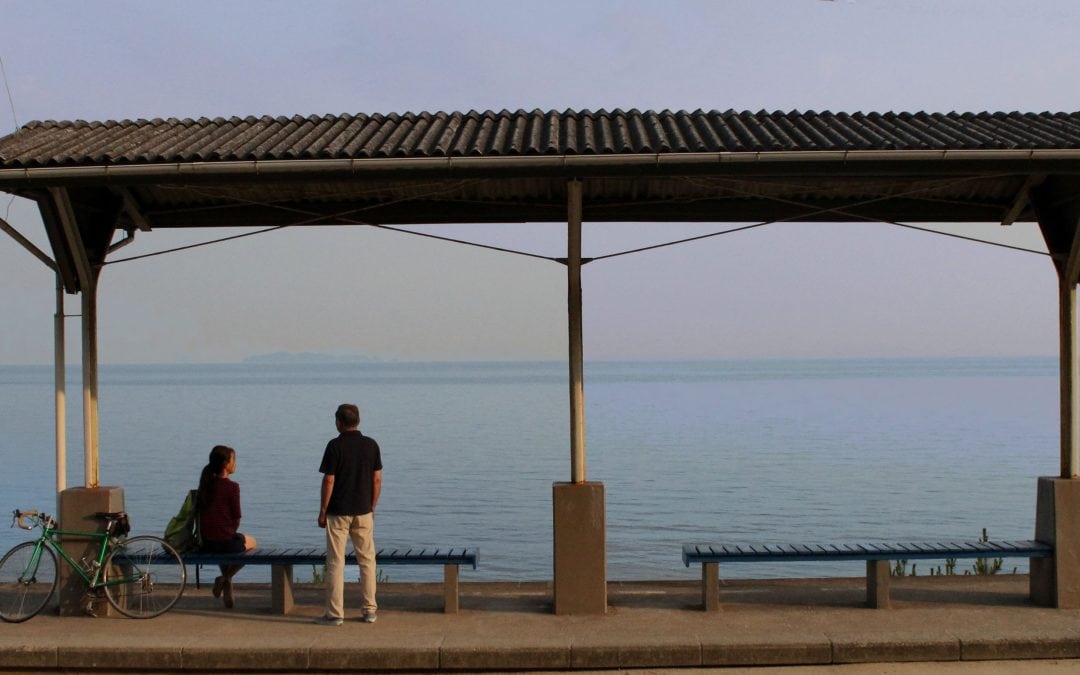Mention Shikoku to the average Tokyo-ite and their eyes will widen, they’ll break into a broad smile, and admit they’ve always wanted to go. They’ll tell you that they’re planning to buy motorcycles to tour the island’s hundreds of coastal roads, complete the sacred 88 temple pilgrimage, or leave the stressors of the daily grind behind as they dive into a transparent mountain river. Shikoku is an island, the smallest of the four main islands of Japan, that’s steeped in mystery, known for its wilderness. This is the place, in fact, where Haruki Murakami sent the central character in his novel Kafka by the shore when he wanted to escape the oppressive closeness of Japan’s metropoles – to connect with a more authentic, primitive, and mindful version of himself. This is a place that should be on every traveller’s list. Yes, when you’re in Japan visit Tokyo, Kyoto, and Hiroshima, but after that…Here are 8.8 reasons to choose the path that heads south.
1. Nature
When it comes to the outdoors, Shikoku has it all. On the southern coast, you’ll find the beaches of Tokushima and Kochi. 3 km stretches of white sand that back onto the mountains and their forests. This is where both international surf competitions are held and turtles scurry ashore to lay their eggs. Testament to the consistent waves of the Pacific and the largely unpolluted, unspoilt landscape. As you head north the scenery becomes more mountainous. In the middle of the island sits Mount Ishizuchi, the highest peak in western Japan at 1,982 metres, and a place of enormous spiritual importance. It’s one of Japan’s seven holy mountains and has shrines dotted on many of its faces. Autumn is a particularly good time to visit as the fall colours are resplendent and the drive to the head of the trail, shrouded in reds, oranges, and yellows as well as every hue in between, is unforgettable. Mountains bring all manner of gorges – some with unthinkably steep sides into which rice fields have been cut, some with waterfalls under which you can cool off, some with rivers down which you can raft or canyon, and some with evocative names such as The Belly of the Dragon. Setting up a stove next to a two-metre waterfall, jumping into the frigid pools and then warming up with some hot chocolate isn’t a bad way to spend an afternoon. Finally, the mountains give way to the calm waters of the Seto-Inland sea to the north. This coast is different in feel to the south – more developed perhaps, but stiller, more considered, with hundreds of uninhabited islands disappearing into ever lighter shades of grey towards the horizon. Local fishermen stand on rocks trying their luck with squid, seabream, or whatever happens to be in season. As you sit in a small train station that faces onto the sea, looking onto the still waters, it’s easy to get lost in thought. It’s a place where you can spend time not doing much, but then that’s what the nature of Shikoku offers you – an opportunity for peace, a chance to stay still, and that is an absolute treat in a country that seems to be in constant motion.
2. Food
The food in Shikoku is first class. Here the ingredients are as fresh as you would want them and the price is much lower than you’re likely to find elsewhere in Japan. You can get a bowl of Sanuki udon, a delicious dry noodle dish that’s only served in a small part of the north-east of the island, for a few hundred yen. Foodies regularly travel from Tokyo for a couple of bowlfuls of the noodles here. The waters of the Seto-Inland Sea to the north and the Pacific Ocean to the south provide plentiful supplies of a variety of fish. In the south, this fish is lightly cooked over burning hay and served with slices of garlic – simply perfect. In the east and west you’ll find traditional ingredients such as rock tofu and yuzu, fruit and veg sold on the roadside, and a level of pride that comes with serving something that has been passed down from generation to generation for hundreds of years.
3. The people
The people of Shikoku are welcoming and inviting. They are proud of their heritage and more than happy to share it with those who make the journey across the bridge. The four prefectures, Ehime, Kagawa, Tokushima, and Kochi, have a different feel from one another, but in general, it’s the kind of place that, no matter where you are, people will be interested in you and are likely to be happy to talk. Great travel is not really about the places you go, and the things that you see. Of course, that’s important, but at its heart, excellent travel involves getting to know a community. And that is something that rural Japan, and Shikoku particularly, facilitates.
4. Festivals
Shikoku is home to some of the most unusual festivals in Japan. This is an island of tradition and history – there was no bridge to the main island until thirty years ago – so the culture and rites here are unlike others you’ll see. Portable shrines carried by hundreds of men smashing into each other at daybreak, men dressed in loincloths throwing the same portable shrine into the sea to cleanse the goddess within, groups hurtling a 600m firelit course with tree trunks on their shoulders being showered with ice cold water from the excited crowds, street dances lasting several days and involving literally thousands of people, the list could go on and on. Festivals are a wonderful frame onto a local community, and that is 100% true in Shikoku. If you’re lucky enough to be here during one of these spectacles, my advice is soak up the atmosphere as much as you can, it’s unlike anything else you’ll experience in Japan.
5. Adventure
With all this nature Shikoku is a truly wonderful place to explore. For the adrenaline junkies, there’s world-class rafting, surfing, canyoning, and paragliding. You can also scuba dive or snorkel with tropical fish, go whale watching, and hike many of the mountains and gorges. There’s also the Shimanami Kaido, the world’s longest series of bridges, that connects Onomichi on Honshu with Imabari on Shikoku. The ride is 70kms long and while it can be done in a day, it’s best to take your time and explore each of the islands you visit. This is the perfect chance to experience rural Japan.
6. Onsen
Onsen (hot springs) have importance far beyond personal hygiene in Japanese culture. They offer families the chance to relax together and individuals the opportunity to wash away the pressure of the daily grind and reconnect with nature. And Shikoku in general, and Ehime prefecture in particular, is the home of hot springs in Japan. It has the oldest one in Dogo Onsen, Matsuyama. The story goes that a crane was flying across the island with an injured leg. It landed in Matsuyama and walked through the healing waters. The locals, observing the miraculous recovery, realised the power of the waters and started work on the hot spring immediately. But outside of Matsuyama there are also some special waters, many of them include rotemburo (baths that are in the open air). There’s a salt water bath overlooking the sea from which you can watch the setting sun, a bath next to the wild waters of the Iya valley that you can only access by funicular railway, as well as many hundreds of small baths up in mountain complexes from which you can consider the natural world, your place within it, or whatever else may happen to come to mind.
7. The 88 temple pilgrimage
This gruelling 750-mile tour of the coastline traces the footsteps of Kobo Daishi, the most revered figure in Japanese Buddhism, who visited Shikoku on many occasions. The journey takes around 45 days to walk, and is traditionally completed on foot. Ohenro (pilgrims) can be recognised by their white clothes, bamboo hats, and chin-high wooden walking sticks that they use to climb the trails and mountain paths as they weave between the 88 temples. Although originally connected to Buddhism, the journey is completed these days for a number of reasons – religious, contemplative, touristic – but unlike the other major pilgrimages of the world, this one has no true end, no true beginning – the pilgrimage is circular. The goal is not to get to the destination, but to think about the journey. When you finish you are back to the start – the location the same, but the scenery has changed – different because the journey has altered the manner in which you see the world. Most cannot make the whole journey, but it’s still nice to visit one or two temples and make time for quiet thought.
8. You can choose your own adventure
Cities require you to go from one attraction to the next, jumping between tourist sites and places of interest. In many ways, it’s difficult to truly be in control of a visit to an urban centre. With a visit to the Japanese countryside, this isn’t the case. The best experiences come in exploring places that are not listed in most guidebooks, and about which you cannot find out everything before you travel. While Shikoku does have enough attractions to keep you busy for months, there’s no checklist. On Shikoku you can make your own fun, choose your own adventure. There’s freedom that comes with not having to visit any specific place, it means you can go anywhere you like. And truly being in control of your itinerary is the best way to travel.
8.8 Not many people do
Any list of Shikoku needs to reflect the pilgrimage, and so we come to 8.8. Shikoku is the least visited of the four main islands. Most Japanese people have never been there, and the same is true for international visitors. This, in itself, is reason to go. You will be off the beaten track, forging a path of your own. More challenging perhaps, more difficult, but ultimately more rewarding. In truth, you’ll never be far from civilisation and there are a number of cities on Shikoku, but if it’s the urban life you’re after, stay on Honshu. But for those who do choose the road less taken, even for only a few days, you’re in for an unforgettable experience.


Recent Comments